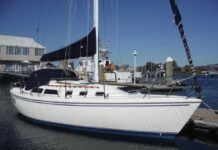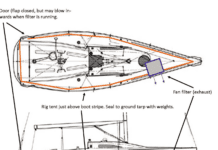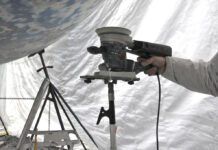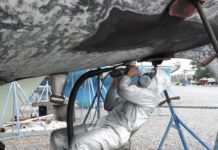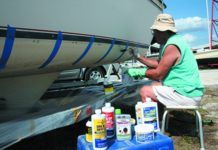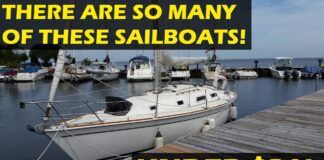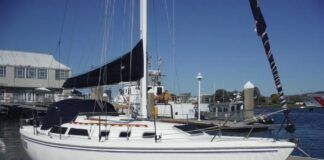Furlex Dust Cover
As always, I enjoy reading of Nick’s adventures aboard Calypso. It was nice to hear how happy he was with the performance of his Furlex during his circumnavigation (June 2001).
He mentioned that the dust cover on the halyard swivel would not stay in place. Please let your readers know that we have changed the design of the cover to remedy this problem. We would be pleased to send Nick or any Furlex owner a replacement dust cover free of charge. Please contact us at the address below or visit www.seldenmast.com for an authorized dealer nearby.
-Scott Alexander
Selden Mast, Inc.
4668 Franchise St.
North Charleston, SC 29418
843/760-6278
———-
Brokers
I was so looking forward to your recent boatbuying issue where I assumed you would expose the fraudulent relationship between boat brokers and surveyors. Having a great deal of respect for your publication I assumed you would survey a number of boats that were for sale using the surveyor recommended by the broker and then you would later have it surveyed by an independent surveyor. Can you image the results?You would forcefully and tangibly demonstrate to your readers the dirty little secret between brokers and some surveyors. Not only would this alert your readers but it might act as an agent for change. Instead there was one line that said don’t do this. Thats it? I thought you were the heavyweight not-afraid-of-anyone-in-the-industry crusader. Shame on you.
Having bought a boat and been the victim of a bad surveyor, the financial costs are much greater than the total price of 99% of the products you review. And as you know or don’t know, one has almost no recourse with a bad surveyor. If the surveyor has insurance, which most don’t, you can sue and possibly win after great expense and time. If the survey is done out of state it becomes much more complicated if not impossible to sue.One quickly finds out that the Society of Accredited Marine Surveyors or SAMS is merely a trade organization with no authority to deal with the actions of its membership.I understand most surveyors are decent but there is an obvious problem as you are well aware.
-Todd E. Grady
Andover, MA
Author’s Note: When I was planning the article with other editors, we were of a like mind: Our intention was to ferret out as many cases of broker and surveyor malfeasance as possible. We rarely shy from opportunities to bring such incidents to light.
In this case however, there simply were not enough cases of broker misconduct to draw a harsher or broader conclusion. I understand and sympathize with your particular situation. But in this case, exhaustive research, interviews, Lexis searches, court dock et searches, and inquiries to both the Florida and California government agencies who regulate boat brokers turned up only a handful of cases. Although there are always bad apples like in your case, boat brokers really do seem to be an honest bunch. We therefore played the hand we were dealt.
Editor’s Note: You can’t win. See the next letter.
As a yacht broker, and as president of the Yacht Brokers Association of America, I read with keen interest the article in which you describe to your readers how they need to protect themselves from those in my profession. (“How Not to Get Ripped Off,” June 2001).
The alarming and sensational tone of the article provided entertaining reading.
Rather than take Practical Sailor to task for not bothering to invest the few minutes it would have taken to communicate with our association prior to publishing this article (although you did reference our website, without attribution) or quibbling about the accuracy of numbers of fraudulent and negligent transactions, I would prefer to endorse one of the recommendations made within the article.
You recommend that a buyer “investigate a broker’s reputation.” I strongly suggest that your readers conduct business with yacht brokers who are members of the only national association dedicated to the integrity of the profession. The Yacht Brokers Association of America (YBAA) is the largest professional yacht brokers organization in the world, serving members in 24 US states, Puerto Rico, and Canada, as well as Italy and the UK. Member brokers pledge to observe a strict Code of Ethics that provides clear guidelines in dealing with all parties in a transaction. Standardized business forms, such as Purchase and Sale Agreements, utilized by member brokers, have been carefully reviewed for strict legality and impartiality. Membership is subject to peer review.
YBAA is currently in the midst of developing a national yacht broker certification program, which will raise the bar of professionalism within our industry, and will provide another level of confidence and support for boat owners. Visit our website at www.ybaa.com, or call the YBAA office in Annapolis at 410/263-1014.
-Brian Commette
Northrop & Johnson, Inc.
President, YBAA
———-
Rubber Impellers
With reference to Will McCains letter in the June 2001 issue, it is important that your readers appreciate one critical technical difference between engine raw water cooling pumps and engine closed circuit cooling pumps.
All engines have a raw water cooling pump (except closed circuit, keel cooled engines), irrespective of whether the engine is directly cooled by pumping the raw water through the block, or indirectly cooled by pumping the raw water through a heat exchanger where the raw water cools the fresh water in the closed circuit.
Most raw water cooling pumps, for pleasure boat applications, must be self-priming. Most marine engines use self-priming flexible impeller pumps such as those manufactured by our company.
Engines which are indirectly cooled must also have a second pump to circulate the fresh water through the engine block and through the heat exchanger. This pump does not need to be self-priming, so it can be a simple non-self-priming centrifugal pump, usually engine driven by gear or belt, like the flexible impeller pump, but it can be dc motor driven.
Buses and trucks commonly use low flow, long life, DC-motor driven, non-self-priming centrifugal pumps to circulate the hot, closed circuit engine cooling water through heating radiators, and I suspect that it is one of this type of pump that Alvah Simon used.
If such a pump ever lost its prime, for example in rough seas, and became air locked, it may not re-prime, even in a flooded suction position.
We can assure you that marine engine manufacturers continue to fit self-priming flexible impeller pumps because, on balance, they are the most cost effective and reliable solution currently available.
-Geoff Sheddick
ITT Industries Jabsco
———-
On Boat Owning
Doug Logan says “The trick is to have the boat that lets you cast off and go.”(June, 2001). Right on! One thing that stops or ruins many a good sail/cruise is all the electronic wonders we insist on putting aboard. Many folks think they cannot leave the dock without them. Then there are the hours spent repairing and fussing when we could be out on the water. I remember returning from a glorious two-week vacation cruise and chatting with a very sad fellow sitting in the cockpit on his loaded-with-everything-electronic 40 foot-wonder. At the beginning of his vacation, his LORAN went on sabbatical and he blew his vacation troubleshooting and repairing and replacing.
I have GPS and some other gadgets on my boat. And they are no doubt fun and convenient. But I never would go off shore if I felt I could not return to my mooring unless the electronic things all worked. When I want to sail, I sail. If the gadgets work, fine. If not, 30 seconds of irritation is followed by casting off.
Remember: KISS! Cheers to a great and useful magazine.
-Barrie Smith
Punta Gorda, FL
———-
Im one of those guys sitting on a 5- tonner fiddlingand waiting for crew, and except for the desire to sail a little more I like what Im doing. If I wasnt one of those guys I wouldnt be buying your magazine! “Someday” boats don’t happen overnight for a lot of us. For those with large sums maybe, but the rest of us have to be smart to acquire what is usually only available to the rich.Buying an old boat really brings to light how vulnerable we are mechanically-it’s been a real eye opener for me.
-George Rohrer
Via e-mail
Editor’s note: One measure of a boat’s worth is how happy it makes its owner, no matter how it’s designed or built, what kind of shape it’s in, or whether it’s underway or not.
Those who have little money to buy labor and expert help won’t stay around boats long if they can’t learn to enjoy tinkering and troubleshooting about as much as they enjoy sailing itself. However, a fixer-upper that eventually goes sailing is one thing; a boat fully preened and idle at the dock is another. We’d rather be sailing.
———-
Pulling Calypso Off
In response to several readers who asked why we didn’t try pulling Calypso off the Red Sea reef by means of a halyard from the masthead, the quick answer is that time was of the essence. The keel was wedged between two coral heads, and I was afraid we were at the top of a four-foot tide. With deep water close at hand, getting the anchor out in that direction was more practical, as I thought I could pivot the boat toward the deep water.
Heeling the boat is fine when you’re stuck in mud or sand, but on an irregular coral bottom, you need to keep things under control as much as possible, and be careful not to jam the boat more into the coral.
At the end of the day, sliding the boat straight backward the way she came on was the answer, and that is what we accomplished by putting the boat astern. The anchor to one side and astern, in deep water, pivoted the bow as soon as the keel backed off the coral heads.
-Nick Nicholson
aboard Calypso
———-
Small Battery Charger
Your article on Small Batteries, Chargers (June 2001) overlooked an excellent “smart” charger for NiCad and NiMH batteries: the MAHA MH-C777 Universial Charger/Conditioner. It automatically handles batteries between 4.8 and 12 volts, including standard cells in groups of 4 or 8. It is very effective charging handheld batteries with its adjustable contacts. It detects reverse polarity, has a built in conditioner, and uses deltaV and temperature sensing to avoid overcharging. It can be powered directly from 12 volts. It can be ordered from Thomas Distributing (www.thomasdistributing.com) for $44.90.
-Joe Urban
Richmond, Virginia


